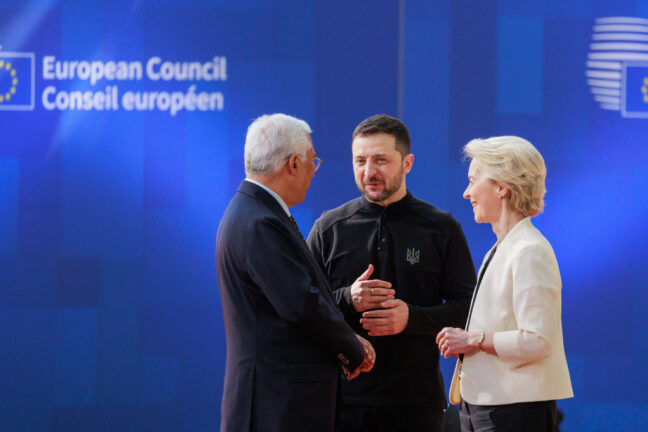The European Union must act fast to find the money needed to strengthen the continent’s defence, heads of EU member states agreed at Thursday’s extraordinary European Council summit. However, the plan, presented by the European Commission on Tuesday, leaves out some of the most efficient options of doing so.
“Russia’s aggressive war against Ukraine and its implications for European and global security in a changing environment pose an existential challenge for the European Union,” the European Council concluded Thursday’s extraordinary meeting.
The leaders welcomed the Commission’s intention to allow member states to break debt rules in order to invest in security, and called for other sources of funding to be found. European Commission President Ursula von der Leyen presented her five-point plan on Tuesday.
The first step is to include the activation of the escape clause of the EU’s Stability and Growth Pact limiting budget deficits among EU countries, to allow for higher national defence spending without triggering the bloc’s excessive debt procedure.
You might be interested
As a second step, the EU will propose €150 billion in loans to boost defence spending for joint procurement in a wide range of capabilities such as air defence, drones, military mobility or cyberdefence. The EU27 has already done this once – joint borrowing was used to rebuild European economies during the Covid-19 pandemic.
A third option would be to propose “additional possibilities and incentives” for EU countries if they decide to use cohesion programmes to boost defence spending.
The fourth is to mobilise private capital through the EU Savings and Investment Union. On Thursday, the Commission has produced a draft communication identifying the policies needed to advance the SIU; the text is expected to be adopted on 19 March.
The fifth option consist in a direct involvement of the European Investment Bank (EIB).
Policies, not markets
While the speed of the EU institutions on boosting defence spending is impressive in the context of Brussels bureaucratic process, the plan also means that the Union has left out potentially efficient financing options. Those could have included steps such as issuing defence Eurobonds, or confiscating frozen Russian assets.
A number of questions remain open: where exactly to take the money, how to spend it and how to coordinate the individual countries‘ actions. Arms spending is primarily a matter for nation states. It is not clear, for example, whether the countries should be buying American weapons or look elsewhere.
The fragmentation of the EU defence scene poses yet other problems. As Defence Commissioner Andrius Kubilius pointed out during Thursday’s meeting of the European Parliament’s Foreign Affairs Committee, „arms spending is not a market-driven, but a policy-driven“ matter. As a result, it doesn’t lend itself well to a single-market treatment. European states thus compete with one another, both raising prices and inviting interoperability problems.
Despite broad political support, the devil remains in the detail for many EU countries. The militarily neutral European countries – Austria, Ireland and Malta – have cautiously indicated their tentative agreement with the bloc’s defence moves. The Netherlands secured a modification of today’s conclusions to “ensure debt sustainability” when considering national defence spending, allaying its concerns about proposed changes to EU fiscal rules.
Ms von der Leyen is expected to present the revised plan within the next two weeks; it could then be approved at the next EU summit on 20 March.











